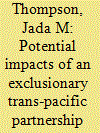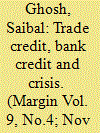|
|
|
Sort Order |
|
|
|
Items / Page
|
|
|
|
|
|
|
| Srl | Item |
| 1 |
ID:
142019


|
|
|
|
|
| Summary/Abstract |
Within the context of the Period Fixed-Effects Model, this study of cigarette consumption in the US uses a state-level panel dataset to investigate a new hypothesis. This hypothesis argues that the presence in the home of minor-aged children, that is, children under 18 years of age, reduces the percentage of the population that smokes cigarettes. The eclectic model includes the levels of federal plus state cigarette excise taxation along with a number of other established explanatory variables. The empirical estimates in this preliminary study find support for the hypothesis proffered here, that is, it is found that the percentage of the population that smokes cigarettes is a decreasing function of the percentage of households with minor-aged children residing in the home. Moreover, aside from providing further insight into smoker behaviour, the results from this study also raise the question that since this phenomenon has been ignored in previous related studies involving such public policies as cigarette taxation and cigarette smoking bans that those studies may suffer from omitted variable bias.
|
|
|
|
|
|
|
|
|
|
|
|
|
|
|
|
| 2 |
ID:
142017


|
|
|
|
|
| Summary/Abstract |
This article attempts to present a framework for the estimation of fiscal multipliers for the Indian economy in the structural macroeconomic modelling tradition. Empirical estimates of short-run multipliers are obtained by giving shocks to a range of fiscal instruments—expenditures and taxes. As per our estimates, the values of the capital expenditure multiplier, transfer payments multiplier and other revenue expenditure multiplier are 2.45, 0.98 and 0.99, respectively, while the tax multipliers are around −1. Expenditure multipliers were also obtained in the presence of fiscal consolidation targets. These estimates again point to the strong multiplier effect of capital expenditure on output, and underscore the need to prioritise capital expenditure.
|
|
|
|
|
|
|
|
|
|
|
|
|
|
|
|
| 3 |
ID:
142016


|
|
|
|
|
| Summary/Abstract |
The Trans-Pacific Partnership (TPP) is a free trade agreement that hopes to eliminate all tariff and non-tariff trade barriers between 12 participating countries. Japan, the fourth-largest trading partner for the United States, is a significant player in the negotiations. Due to cultural and historical significance it is expected that Japan will ask for exclusions on agricultural products, limiting the overall effectiveness of a fully liberalised agreement. Using a computable general equilibrium modelling framework across varying scenarios, we show the difference between the full liberalisation and potential exclusionary scenarios. Estimates show that a 25 per cent reduction in import tariffs on agricultural commodities in Japan results in a difference of net welfare benefits equal to –USD 7 billion, emphasising the importance of these concessions.
|
|
|
|
|
|
|
|
|
|
|
|
|
|
|
|
| 4 |
ID:
142018


|
|
|
|
|
| Summary/Abstract |
This article analyses the degree of stock market efficiency in three emerging economies— India, China and Brazil. It tests to see if US stock returns have an influence on endogenous stock returns, even after controlling for domestic macroeconomic variables. A country-specific vector auto-regression model is used to test the short-run effects and the fully modified ordinary least square procedure has been used to find the long-run relationship, thus checking for degree of efficiency in these stock markets. The results indicate that, despite controlling for key domestic stock return determinants, US stock returns have a significant positive relationship with the stock returns of all three countries.
|
|
|
|
|
|
|
|
|
|
|
|
|
|
|
|
| 5 |
ID:
142015


|
|
|
|
|
| Summary/Abstract |
Employing data on an extended sample of manufacturing firms during 1993–2012, the article studies the inter-linkage between trade credit and bank credit and how it evolved during the crisis. Accordingly, we first discuss the relevance of a trade-credit channel in India and subsequently, explore the interplay between these two financing forms. The analysis provides some evidence in favour of a trade-credit channel in India. More importantly, the findings indicate that bank credit and trade credit are complementary, although there was a differential impact on accounts payable (demand) and accounts receivables (supply) during the crisis.
|
|
|
|
|
|
|
|
|
|
|
|
|
|
|
|
|
|
|
|
|